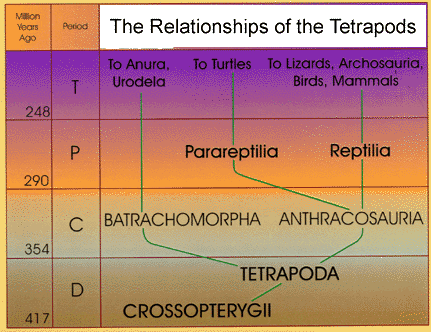
Fossil
evidence of the earliest terrestrial vertebrates is insufficient.
It seems that
at the beginning of the Devonian Period, more than 400 million years ago,
some
ancient lobe-finned fishes gave rise to ancestors of the tetrapod, which invaded
coastal
shoals. The most ancient tetrapod animals are amphibians of the order
Ichthyostegalia,
known only from the Late Devonian of Greenland.
There were already several groups
of primitive four-footed amphibian
vertebrates at the beginning of the Carboniferous
Period.
All of them are united with ichtyostegalians in the subclass Labyrinthodontia.
The
labyrinthodonts are distinguished by a deeply folded structure of enamel
and dentine
layers in the teeth, that look like a confused labyrinth
on the cross section,
hence the name of this group.
Labyrinthodonts were probably very similar to fishes
in their style of life.
Labyrinthodonts, like fishes and most modern amphibians,
laid eggs in the water,
where their larvae developed into mature animals. All
labyrinthodonts had special
water sense organs, forming a system for perception
of water fluctuations.
Moreover, some of them possessed well-developed gills.
On
the other hand, many labyrinthodonts seemingly had primitive lungs.
They could
breathe atmospheric air, a great skill for residents
of warm shoals with low oxygen
levels in the water.
The air was inflated into the lungs by contractions of a
special throat sac.
Primitive representatives of all groups of labyrinthodonts
were probably true water
predators, and only their advanced forms, arisen independently
in different groups
and in different time, gained an amphibious, semi-aquatic
mode of life.
Mature individuals of advanced labyrinthodonts could live on the
land,
feeding mainly on insects and other small invertebrates.
Well-ossified
robust skeletons in some Late Carboniferous and Early Permian labyrinthodonts proves
their adaptation to the terrestrial mode of life.
It suggests that amphibians
had successfully "organized" worthy terrestrial
assemblages prior to
the wide expansion of reptiles.
The
most diverse group of the labyrinthodonts was the batrachomorphs ("similar to
a
frog"). Though these animals looked more like crocodiles, they most probably
gave rise
to the order Anura, the tail-less amphibians, which include, in particular,
modern frogs.
Batrachomorphs appeared in the Late Devonian, but they had worldwide
distribution in
continental shallow basins of the Permian (Platyoposaurus,
Melosaurus) and Triassic
Periods (Thoosuchus,
Benthosuchus, Eryosuchus).
Some
batrachomorhs existed until the end of the Cretaceous.





